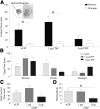μ-Opioid receptors within subregions of the striatum mediate pair bond formation through parallel yet distinct reward mechanisms
- PMID: 23699524
- PMCID: PMC6705037
- DOI: 10.1523/JNEUROSCI.4123-12.2013
μ-Opioid receptors within subregions of the striatum mediate pair bond formation through parallel yet distinct reward mechanisms
Abstract
The prairie vole is a socially monogamous rodent that is an excellent animal model for studies of the neurobiology of social attachment. Such studies have demonstrated that activation of reward circuitry during social interactions facilitates pair bond formation. Within this circuitry, μ-opioid receptors (MORs) modulate naturally rewarding behavior in an anatomically segregated manner; MORs located throughout the striatum (dorsal striatum, NAc core, and the entire NAc shell) are implicated in general motivational processes, whereas those located specifically within the dorsomedial NAc shell mediate positive hedonics (and are referred to as a "hedonic hotspot"). The purpose of the present study was to determine whether MORs within these distinct subregions differentially mediate pair bond formation. We first used receptor autoradiography to compare MOR binding densities between these regions. MOR binding was significantly higher in the NAc core and dorsomedial NAc shell compared with the ventral NAc shell. We next used partner preference testing to determine whether MORs within these subregions differentially mediate pair bonding. Blockade of MORs using 1 or 3 μg of H-d-Phe-Cys-Tyr-d-Trp-Arg-Thr-Pen-Thr-NH2 within the dorsal striatum decreased mating during the cohabitation period and inhibited partner preference formation. In contrast, blockade of MORs within dorsomedial NAc shell inhibited partner preference formation without effecting mating behavior, whereas other regions were not involved. Thus, MORs within the dorsal striatum mediate partner preference formation via impairment of mating, whereas those in the dorsomedial NAc shell appear to mediate pair bond formation through the positive hedonics associated with mating.
Figures





Similar articles
-
Activation of μ-opioid receptors in the dorsal striatum is necessary for adult social attachment in monogamous prairie voles.Neuropsychopharmacology. 2011 Oct;36(11):2200-10. doi: 10.1038/npp.2011.117. Epub 2011 Jul 6. Neuropsychopharmacology. 2011. PMID: 21734650 Free PMC article.
-
κ-Opioid receptors within the nucleus accumbens shell mediate pair bond maintenance.J Neurosci. 2012 May 16;32(20):6771-84. doi: 10.1523/JNEUROSCI.5779-11.2012. J Neurosci. 2012. PMID: 22593047 Free PMC article.
-
Nucleus accumbens μ-opioid receptors mediate social reward.J Neurosci. 2011 Apr 27;31(17):6362-70. doi: 10.1523/JNEUROSCI.5492-10.2011. J Neurosci. 2011. PMID: 21525276 Free PMC article.
-
Aversive motivation and the maintenance of monogamous pair bonding.Rev Neurosci. 2013;24(1):51-60. doi: 10.1515/revneuro-2012-0068. Rev Neurosci. 2013. PMID: 23314526 Review.
-
The ties that bond: neurochemistry of attachment in voles.Curr Opin Neurobiol. 2016 Jun;38:80-8. doi: 10.1016/j.conb.2016.04.011. Epub 2016 Apr 30. Curr Opin Neurobiol. 2016. PMID: 27131991 Free PMC article. Review.
Cited by
-
Neurobiological mechanisms of social attachment and pair bonding.Curr Opin Behav Sci. 2015 Jun;3:38-44. doi: 10.1016/j.cobeha.2015.01.009. Curr Opin Behav Sci. 2015. PMID: 26146650 Free PMC article.
-
Serotonin 1A agonism decreases affiliative behavior in pair-bonded titi monkeys.Horm Behav. 2016 Nov;86:71-77. doi: 10.1016/j.yhbeh.2016.10.001. Epub 2016 Oct 3. Horm Behav. 2016. PMID: 27712925 Free PMC article.
-
[Neural pathway between the nucleus accumbens and the rostral ventrolateral medulla in a rat model of anorexia nervosa].Nan Fang Yi Ke Da Xue Xue Bao. 2020 May 30;40(5):609-615. doi: 10.12122/j.issn.1673-4254.2020.05.01. Nan Fang Yi Ke Da Xue Xue Bao. 2020. PMID: 32897201 Free PMC article.
-
Interplay between the oxytocin and opioid systems in regulating social behaviour.Philos Trans R Soc Lond B Biol Sci. 2022 Aug 29;377(1858):20210050. doi: 10.1098/rstb.2021.0050. Epub 2022 Jul 11. Philos Trans R Soc Lond B Biol Sci. 2022. PMID: 35858101 Free PMC article. Review.
-
Opioid hedonic hotspot in nucleus accumbens shell: mu, delta, and kappa maps for enhancement of sweetness "liking" and "wanting".J Neurosci. 2014 Mar 19;34(12):4239-50. doi: 10.1523/JNEUROSCI.4458-13.2014. J Neurosci. 2014. PMID: 24647944 Free PMC article.
References
-
- Ahern TH, Young LJ. The impact of early life family structure on adult social attachment, alloparental behavior, and the neuropeptide systems regulating affiliative behaviors in the monogamous prairie vole (Microtus ochrogaster) Front Behav Neurosci. 2009;3:17. doi: 10.3389/neuro.08.017.2009. - DOI - PMC - PubMed
Publication types
MeSH terms
Substances
LinkOut - more resources
Full Text Sources
Other Literature Sources
Research Materials
